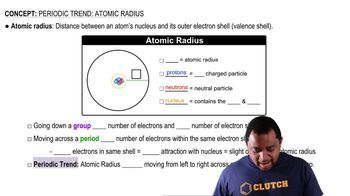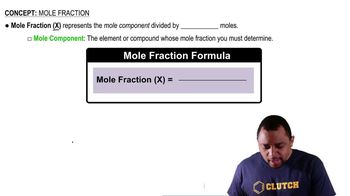A catalytic converter in an automobile uses a palladium or platinum catalyst (a substance that increases the rate of a reaction without being consumed by the reaction) to convert carbon monoxide gas to carbon dioxide according to the reaction: 2 CO(g) + O2(g) → 2 CO2(g) A chemist researching the effectiveness of a new catalyst combines a 2.0:1.0 mole ratio mixture of carbon monoxide and oxygen gas (respectively) over the catalyst in a 2.45-L flask at a total pressure of 745 torr and a temperature of 552 °C. When the reaction is complete, the pressure in the flask has dropped to 552 torr. What percentage of the carbon monoxide was converted to carbon dioxide?
Ch.6 - Gases
Chapter 6, Problem 130
The radius of a xenon atom is 1.3×10– 8 cm. A 100-mL flask is filled with Xe at a pressure of 1.0 atm and a temperature of 273 K. Calculate the fraction of the volume that is occupied by Xe atoms. (Hint: The atoms are spheres.)
 Verified step by step guidance
Verified step by step guidance1
Calculate the volume of a single xenon atom using the formula for the volume of a sphere: $V = \frac{4}{3} \pi r^3$, where $r$ is the radius of the xenon atom.
Convert the radius from centimeters to meters to ensure consistency in units.
Determine the number of moles of xenon gas in the flask using the ideal gas law: $PV = nRT$, where $P$ is pressure, $V$ is volume, $n$ is the number of moles, $R$ is the ideal gas constant, and $T$ is temperature.
Calculate the number of xenon atoms using Avogadro's number, which relates moles to the number of atoms.
Multiply the volume of a single xenon atom by the total number of atoms to find the total volume occupied by xenon atoms, and then divide by the volume of the flask to find the fraction of the volume occupied.

Verified video answer for a similar problem:
This video solution was recommended by our tutors as helpful for the problem above.
Video duration:
10mWas this helpful?
Key Concepts
Here are the essential concepts you must grasp in order to answer the question correctly.
Atomic Radius and Volume of a Sphere
The atomic radius is the distance from the nucleus of an atom to the outer boundary of its electron cloud. For spherical atoms, the volume can be calculated using the formula for the volume of a sphere, V = (4/3)πr³, where r is the radius. Understanding this concept is essential for determining the volume occupied by individual xenon atoms in the given problem.
Recommended video:
Guided course

Atomic Radius
Ideal Gas Law
The Ideal Gas Law, represented as PV = nRT, relates the pressure (P), volume (V), temperature (T), and number of moles (n) of a gas. This law is crucial for understanding the behavior of gases under various conditions and helps in calculating the total number of xenon atoms in the flask, which is necessary for finding the fraction of volume occupied by the atoms.
Recommended video:
Guided course

Ideal Gas Law Formula
Volume Fraction
Volume fraction is a measure of the volume occupied by a component relative to the total volume of the mixture. It is calculated by dividing the volume occupied by the xenon atoms by the total volume of the flask. This concept is key to solving the problem, as it allows for quantifying how much space the xenon atoms occupy compared to the entire volume of the flask.
Recommended video:
Guided course

Mole Fraction Formula
Related Practice
Textbook Question
1
views
Textbook Question
A quantity of N2 occupies a volume of 1.0 L at 300 K and 1.0 atm. The gas expands to a volume of 3.0 L as the result of a change in both temperature and pressure. Find the density of the gas at these new conditions.
Textbook Question
A mixture of CO(g) and O2(g) in a 1.0-L container at 1.0×103 K has a total pressure of 2.2 atm. After some time, the total pressure falls to 1.9 atm as the result of the formation of CO2. Determine the mass (in grams) of CO2 that forms.
Textbook Question
A mixture of 8.0 g CH4 and 8.0 g Xe is placed in a container and the total pressure is found to be 0.44 atm. Determine the partial pressure of CH4.
